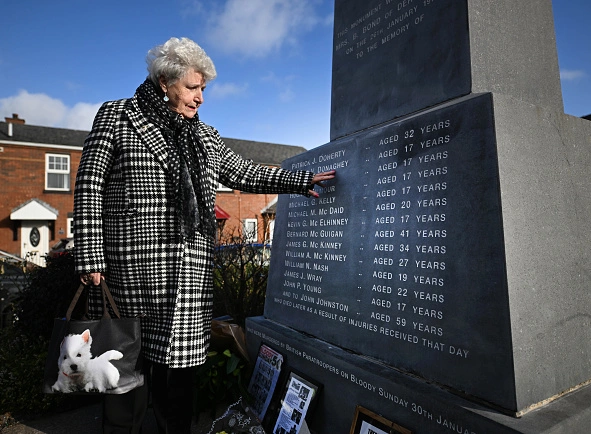
Fifty years since one of the worst massacres in Britain, residents in Londonderry, also known as Derry, have marked the anniversary of Bloody Sunday, when British troops opened fire on civil rights protesters and gave way to decades of chaos in Northern Ireland.
Dublin, January 30 (RHC)-- Fifty years since one of the worst massacres in Britain, residents in Londonderry, also known as Derry, have marked the anniversary of Bloody Sunday, when British troops opened fire on civil rights protesters and gave way to decades of chaos in Northern Ireland.
On January 30, 1972, a British elite parachute regiment shot 14 Catholic marchers dead on the streets of Northern Ireland’s second-largest city.
Retracing the steps of the original march, relatives of the victims staged a walk of remembrance on Sunday. For many of them, memories of that day are still vivid.
Caroline O’Donnell was looking after her five siblings, the youngest of whom was eight months old. “I wanted to go to the march but daddy wouldn’t allow me, so I wasn’t speaking to him,” Caroline O’Donnell told Anadolu news agency.
Her father, 32-year-old Patrick O’Donnel, was killed on the infamous day. “We found out that my father was shot. I’d heard it from somebody in the street. I didn’t know what was going on,” she said. “It just devastated the whole family, devastated me as the oldest. I was very close to my father.”
Another protester, Patrick Doherty, was shot by British soldiers and miraculously survived. His daughter Karen said that while he made it home, the impressions of that day never left him. “He came home probably a different person, psychologically wounded, emotionally wounded, mentally wounded,” she said.
Bloody Sunday was a turning point in three decades of violence in Northern Ireland known as the Troubles, which cost the lives of more than 3,500 people. The conflict was between Northern Ireland’s Catholic nationalists, who want a united Ireland, and Protestant unionists loyal to Britain.
The unauthorised march that resulted in bloodshed had been called for by the Northern Ireland Civil Rights Association (NICRA) to protest the increasing internment without trial of Catholic nationalists since the previous August.
Northern Ireland’s Protestant authorities had declared a year-long ban on all marches amid spiralling unrest since civil rights protesters began demanding an end to voting, housing and job discrimination against the minority Catholic community in 1968.
Nevertheless, at least 15,000 people joined the march, which set off in a carnival-like mood from the Creggan Estate, a few kilometres from the city centre, through the Catholic Bogside district to Guildhall Square.
Crack troops from the British 1st Battalion Parachute Regiment, drafted in that day, were waiting at barricades to stop the march reaching the city centre. Youths began throwing stones at the British army. Troops were ordered to begin arrests and armoured cars drove into the crowd.
At approximately 4:10 pm soldiers started firing and, within about 10 minutes, 13 people were dead and a further 15 injured. Six of the dead were aged 17. The troops claimed to have come under sustained gunfire as well as attacks with nail bombs and that they had aimed away from the demonstrators.
Their claims, largely accepted in the official report by senior British Judge John Widgery, published later that year, were not backed up by independent accounts. No soldiers were injured in the operation and no guns or bombs were recovered. The victims’ families derided the report as a “whitewash.”
The killings proved a boon to the nascent Provisional Irish Republican Army, fighting for Northern Ireland’s reunification with Ireland, whose ranks swelled with new recruits. On February 2, an angry crowd set fire to the British embassy in Dublin. On March 24, London suspended the Protestant-dominated Northern Ireland provincial government, leading to decades of direct rule from the British capital.
The report by senior British Judge Mark Saville concluded that none of the victims was armed, soldiers gave no warnings before opening fire and the shootings were a “catastrophe” for Northern Ireland and led to increased violence.
Following the report then-Prime Minister of the UK David Cameron apologised for the killings, saying: “There is no doubt… what happened on Bloody Sunday was both unjustified and unjustifiable. It was wrong.”
On March 14, 2018, an ex-paratrooper, known only as Soldier F, was charged with murdering two people and the attempted murder of four others. But the charges were dropped in July 2021 after a backlash by MPs from Britain’s ruling Conservative Party members and veterans’ groups, who accused the British state of subjecting old soldiers to a witch-hunt.
Victims and their relatives are still demanding justice. Charlie Nash saw his 19-year-old cousin William Nash killed by one of more than 100 high-velocity rounds fired by members of the British Parachute Regiment on that day.
“We thought there might be rioting, but nothing, nothing like what happened. We thought at first they were rubber bullets,” Nash, now 73, told AFP. “But then we saw Hugh Gilmour (one of six 17-year-old victims) lying dead. We couldn’t take it in. Everyone was running,” he said.
“It’s important for the rest of the world to see what they done to us that day. But will we ever see justice? Never, especially not from Boris Johnson.”
Johnson, the UK prime minister, called Bloody Sunday a “tragic day in our history.” But his government is pushing legislation that critics say amounts to an amnesty for all killings during Northern Ireland’s three decades of sectarian unrest, including by security forces.
Brexit has threatened to destabilise peace in Northern Ireland by putting into question the terms of the Good Friday Agreement (or Belfast Agreement) signed in 1998, which put an end to the Troubles.

